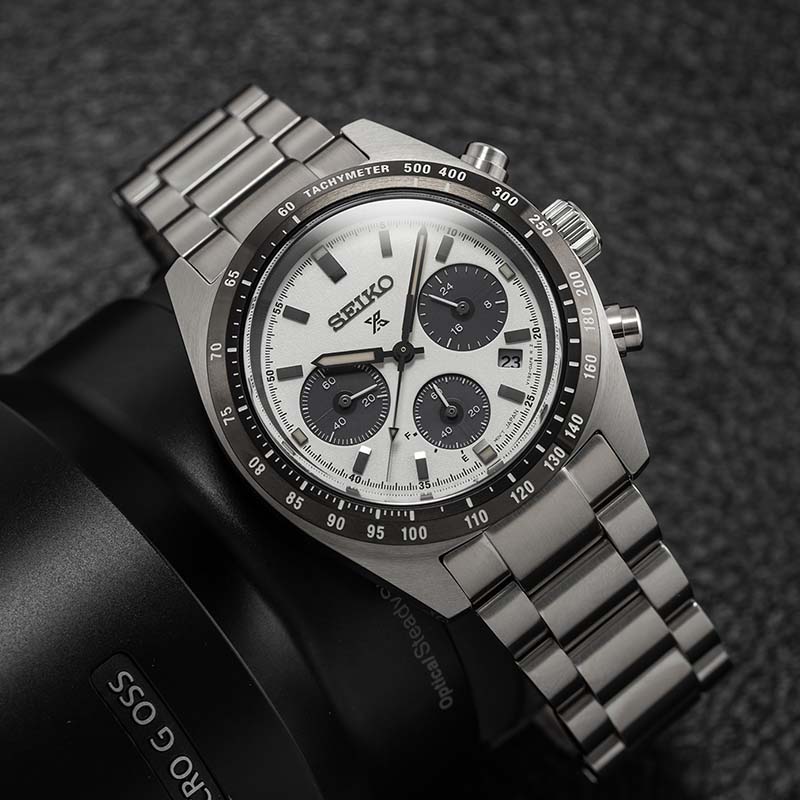Watches with mechaquartz movements are a small but quietly growing niche within the industry, particularly in the ambitious, creative, and extremely budget-conscious world of small independent watchmaking. Watchmakers have discovered that these “hybrid” movements, which offer quartz-level accuracy along with a dose of mechanical appeal, can often provide the opportunity to make chronograph watches that entice watch enthusiasts while still maintaining the affordable price points that keep their brands competitive. But what is a mechaquartz movement, exactly, and what watch brands are currently offering the most interesting examples of this technology? Read on.
What is a MechaQuartz Movement?

In a nutshell, mechaquartz (which various brands and other sources have also spelled mecaquartz, meca-quartz, or mecha-quartz) refers to a chronograph movement that combines a battery-powered quartz crystal oscillator for the main timekeeping (i.e., the hours, minutes, and running seconds) with a mechanical module for the stopwatch functions. The latter element ensures that the chronograph seconds hand sweeps smoothly over the dial, as in a fully automatic watch, rather than in short jumps, as it would operate in a fully quartz one, and that the seconds hand will snap back instantly to zero at the end of a time measurement.
A mecaquartz movement is often referred to as a hybrid movement, but it’s not a hybrid in the same technical sense as, say, Seiko’s Spring Drive calibers, which are more thoroughly explained here. It’s also different from Accutron’s electrostatic calibers (again, more details here), which could be called “hybrid” in that they use the movement of the wearer’s wrists, the primary power source in a self-winding mechanical watch, to power tiny electronic motors that move the watch’s hands. If a watch is mechaquartz, it uses a battery-powered motor, with no mainspring or gear train, to maintain daily timekeeping as well as to power the chronograph functions, the latter of which are otherwise entirely mechanical in their operation.
Where did MechaQuartz Movements Come From?

As one familiar with the history of watchmaking, particularly electronic-adjacent watchmaking, might guess, it is Japan’s Seiko, acknowledged as the primary innovator of quartz movements, that laid the foundation for mechaquartz technology. It is also Seiko that makes the majority of these movements today. including most of those used by the independent brands featured in the list below. In 1980, an era in which digital LCD watches were starting to become ascendant, Seiko bucked the trend by introducing Caliber 7A28, the first analog quartz chronograph movement. However, while this movement was groundbreaking, and indeed set the stage for the “real” mechaquartz calibers of the VK series several years later, it is largely regarded as more of a mechaquartz prototype, because it had no mechanical module for the chronograph.

IWC Pilot's Chronograph with Mechaquartz Caliber 631. Photo: Christie's
Credit for what is considered the first mechanical-quartz movement rightly goes to two Swiss watchmaking companies, Jaeger-LeCoultre and Frédéric Piguet, which teamed up to create Caliber 630, introduced toward the end of the ‘80s and used by IWC in its Flieger and Ingenieur models of the era (see above). It was extraordinarily thin (just 3.7mm) and incorporated two electronic motors, one to drive the timekeeping at 3 Hz, the other to operate the mechanical chronograph at 4 Hz. The follow-up Caliber 631 included a moon-phase. These movements, used up through the 1990s in various watches, were also decorated to a level approaching that of traditional mechanical movements, and the timepieces that carried them were rather expensive.

Photo: WatchCharts
As it has tended to do throughout its history, Seiko eventually brought this technology to a wider audience, introducing the now-ubiquitous Caliber VK63, whose modular design and no-frills, industrial finishing have established the template for mechaquartz movements in the modern era. The key innovation was Seiko's introduction of its Three-Pointed Hammer mechanism, previously used only in automatic mechanical movements, to achieve the very desirable instant-reset function for the chronograph. The VK63 goes by different names — the in-house version used exclusively in Seiko watches was dubbed the 6T63, while that version sold to outside brands is called the VK63 — and like many popular movements, it has expanded into a family. The variations, which can be seen via the dials of watches that contain the movements, are either obvious or subtle.
The original VK63 movement has a three-register chronograph layout, with a 60-minute counter at 9 o’clock, a running seconds display at 6 o’clock, and a 24-hour analog time display in a subdial at 3 o’clock (as below). The VK64, released around the same time as the VK63, uses a two-register display, minus the 24-hour indicator and also minus a date display. Caliber VK67 is very similar to its parent, Caliber VK63, but is designed to record longer chronograph intervals than the 60 minutes allowed by the latter, moving the 60-minute counter to 12 o’clock and adding a 12-hour counter at 9 o’clock. Another iteration, Caliber VK83, uses a 20-minute chronograph counter at 9 o’clock, running seconds at 6, and a 24-hour subdial at 3. All of these have a Seiko-exclusive equivalent (6T64 for the VK64, et cetera) and offer a three-year battery life.
What are the Pros and Cons of MechaQuartz Movements?

As one encounters when comparing any two types of watch movements, the prospective owner of a mechaquartz watch will find both advantages and disadvantages. On the plus side, a mechaquartz movement will tell time more precisely than a mechanical one thanks to its much higher frequency. It can also be much slimmer than a mechanical movement, especially an automatic one with a rotor. From a tactile standpoint, the pushers of a mechanical chronograph mechanism tend to offer a more satisfying experience, with a more solid and forceful click. In the minus column, this type of movement will (of course) require regular battery changes, just like a standard quartz caliber, despite the presence of mechanical parts.
There’s also the potential issue of resetting the chronograph seconds hand precisely to zero after timing an interval. A quartz chronograph movement is designed for the hand to reset perfectly after a battery install, while a mechanical chronograph would need to be manually adjusted if this sequence ever got knocked off course and the hand became misaligned. The biggest positive, of course, is the value proposition; many of the watches spotlighted below come in at an MSRP well under $1,000, and many even under $500, a price point rarely achieved by a chronograph with a mechanical movement.
Some Notable MecaQuartz Watches on the Market Now:
Brew Metric Retro Dial Chronograph ($475)

Brew Watch Company opened its doors in New York City in 2015, founded by industrial designer Jonathan Ferrer and taking its name and inspiration from the concept of the coffee break — i.e., a moment of precious time one takes for oneself. The Brew Metric series of chronographs takes a heaping spoonful of influence from 1970s watch design, with their cushion-shaped cases, integrated single-row bracelets, and minimalist, period-appropriate 36mm sizing (41.5mm lug to lug). The Retro Dial model pictured here ups the ‘70s ante with its use of bright greens, yellows, and orange details on the black dial, which has a quirky asymmetrical layout with a 60-minute counter between 9 and 10 o’clock, running seconds at 6 o’clock, and date window at 4:30. The Seiko-supplied Caliber VK68 hums away inside, behind a caseback adorned with the microbrand’s coffee-bean-inspired logo.
Depancel Allure Chronograph MecaQ 36mm (595 euros)

Founded in 2018, French microbrand Depancel, based in the historical watchmaking village of Besançon, makes wristwatches that are influenced by motorsports and automotive culture. The Allure Chronograph, recently revamped to embrace an even more 1970s aesthetic by founder Clément Meynier, is one of the prime examples, with a 36mm steel tonneau case, a flat sapphire crystal, and an integrated bracelet with uniquely shaped geometrical links. Vivid red and orange, both signature colors of ‘70s watches as well as cars, make their presence felt on the tricompax matte-black dial, which is framed by a racing-inspired tachymeter scale. A Seiko VK63 mechaquartz caliber serves as the engine inside the 50-meter water-resistant case, further driving home (no pun intended) Depancel’s ethos of “blending horological passion and the spirit of gentlemen drivers.”
Dan Henry 1964 Chronograph ($250)

A longtime watch collector, and founder of the historical-watch website Timeline Watch, Dan Henry established his eponymous watch brand in 2016, inspired by his extensive collection of vintage pieces to produce contemporary watches with recognizably retro design language. Each Dan Henry watch model is limited and numbered, and named after the year from which it draws its main aesthetic influence. The mechaquartz-powered 1964 Gran Turismo Chronograph brings to mind iconic racing watches born in the ‘60s like the Heuer Carrera and Rolex Daytona, and Dan Henry makes it in both 36mm and 38mm case sizes, with either a two- or three-register dial design, with or without date display, in two panda colorways as well as a monochromatic slate-grey. The subdials have a subtle snailed texture, an impressive detail at this price level, and the tachymeter ring on the dial’s periphery completes the vintage motoring theme.
Nivada Grenchen Chronoking Aviator Sea Diver ($479)

Founded in 1926, Nivada Grenchen made a name for itself throughout the 1950s and ‘60s with its adventure-oriented dive watches and chronographs. Those vintage models continue to exert a strong influence on the modern incarnation of the brand, which was revived after a long hiatus in 2018 and is today one of the industry’s most closely watched boutique watchmakers. The Chronoking Aviator Sea Diver, introduced in 1963 and relaunched as a limited edition in 2023, has a mouthful of a model name but that’s because there’s so much packed into it. It’s really a dive watch, pilots’ watch and racing chronograph blended into one, with a black aluminum rotating divers’ bezel, a tachymeter scale on the flange of the high-contrast “reverse panda” dial with its three registers, pump-style pushers, and red details on the chronograph hands. The stainless steel case measures an understated 38mm, features a combination of brushed and polished finishing, and houses the Seiko VK64 mechaquartz movement.
Seiko Coutura Quartz Chronograph ($535)

We couldn't leave out the granddaddy of mecha-quartz watches, as well as the movement provider for just about every other brand included in this listing. In truth, Seiko does not make a lot of watches these days that use movements from its mechaquartz caliber family, preferring to lean on its trio of quartz, automatic, and Spring Drive (plus the occasional solar-powered movement) for much of the line. The SBB Coutura series is an exception, projecting an aggressively auto-racing-inspired design spirit and housing the Caliber 8T63, the successor to the 6T63 (aka the VK63, remember), which made its debut in 2015 and offers, Seiko says, a longer battery life and improved accuracy (+/- 15 seconds monthly). The dials host a carbon-fiber pattern that brings to mind a checkered flag and feature a tachymeter ring on their outer edge, while the 42mm stainless steel case and bracelet have sculpted edges and angles inspired by the forms of racecars.
Sternglas Tachymeter 2.0 ($499)

German microbrand Sternglas, founded by web designer Dustin Fontaine in 2016, adheres to a Bauhaus aesthetic and prices its timepieces at an even more accessible level than those of similarly focused brands like Nomos and Junghans, aimed at new and even first-time buyers. The Tachymeter models are the brand’s most avant-garde chronographs, with 44mm steel cases and tricompax dials with dynamic multilevel designs. The two current models, powered by Seiko VK63 movements, feature either a black-and-silver dial with fiery red details or a blue-and-silver dial with bright yellow details. The 44mm steel cases resist water pressure to 100 meters and are topped with double-domed crystals made of sapphire, a luxurious value-add at this price point. The casebacks are engraved with rally-racing-inspired imagery and the watches are mounted on either a steel beads-of-rice bracelet or a dark brown Modena leather strap.
Vaer RS1 Rally Chronograph ($249)

Vaer founders Ryan Torres and Reagan Cook pooled their collective life savings to start their own watch brand because “we couldn’t afford the watches we liked and didn’t like the ones we could afford.” Based in Venice, California, Vaer released its first watches, assembled overseas, in 2017, and began manufacturing in the U.S. just one year later. The RS1 Rally Chronographs take their cues from timepieces worn by race car drivers in the 1960s and ‘70s and hit the accessible price point the brand strives for thanks to their use of a VK63 mechaquartz movement. The 40mm steel cases are offered on a series of interchangeable straps and bracelets, in dial colors of black or cream. The subdials for running seconds and chronograph readouts are TV-shaped rather than round, making for a charmingly odd contrast with the case and dial, and highlighted with bright colors that echo those found in the dial’s tachymeter scale.
Yema Rallygraf ($399)

Founded in Besançon in 1948 by watchmaker Henry Louis Belmont, Yema has had an up-and-down history in the watch world, with ownership changing several times over the years (including a stint in the 1980s when it was owned by Seiko). In 2005, under new French ownership, Yema returned to the scene after a long hiatus and began offering a vast range of watch styles, including the emblematic Superman divers’ watch and the racing-inspired Rallygraf chronograph, which is a modern re-edition of a watch worn by F1 legend Mario Andretti. Powered by a VK64 caliber, the contemporary Rallygraf features the block chrono pushers and double-domed mineral crystal of its predecessor as well as the car-dashboard-inspired subdial arrangement, with a tiny checkered-flag motif between two trapezoidal registers. The black aluminum bezel is etched with a tachymeter scale and the caseback features a relief engraving of Yema’s historical coat of arms.
























































0 Comments